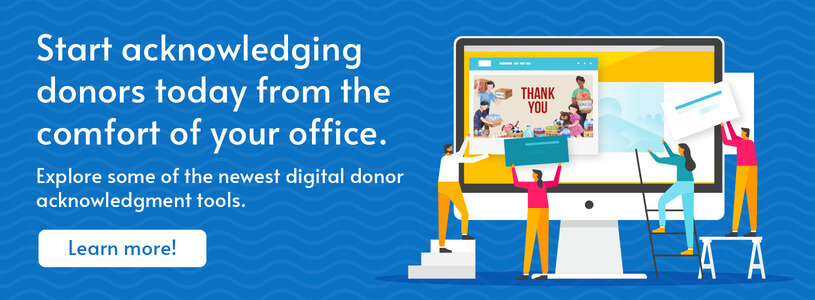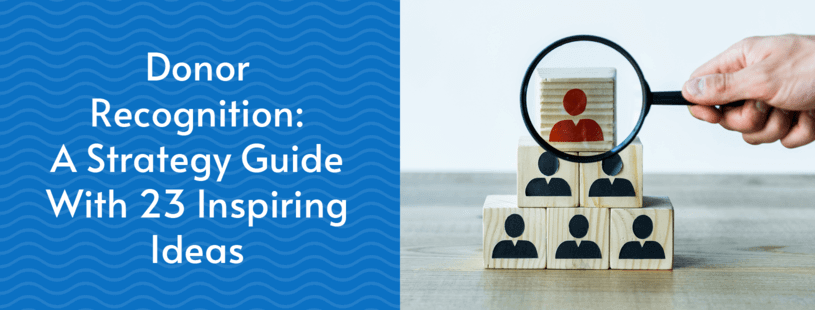
As a fundraising professional, you understand the invaluable role that donors play in advancing your nonprofit’s mission. Now, imagine if you could unlock a secret power that would deepen those connections, inspire unwavering loyalty, and propel your organization to new heights. The key lies in effective donor recognition.
Effectively acknowledging your supporters is a primary part of successfully retaining donors, and showing your appreciation is not something you want to skip in your donor stewardship plan. For nonprofits to reinforce donors’ decisions to give, they need to make them feel seen, which means doing more than sending a tax receipt.
At eCardWidget, we’ve mastered the art of donor recognition. We know that to retain donors, you need to go above and beyond by using creative methods they’ll remember. To help your nonprofit choose thoughtful donor recognition strategies, we’ll dive into the following topics:
- What Is Donor Recognition?
- Why Does Meaningful Donor Recognition Matter?
- Why Donors Stop Giving
- Creating Donor Recognition Tiers
- 8 Best Practices For Your Donor Recognition Strategy
- 23 Donor Recognition Ideas To Improve Retention
It’s only with your donors’ help that your nonprofit can work toward its mission. If you’re ready to reimagine your organization’s donor recognition strategies, let’s dive in.

What Is Donor Recognition?
Donor recognition is the systematic practice of showing appreciation to donors for supporting your nonprofit. Various activities can help recognize your donors, such as sending personalized thank-you letters, calling them, sharing new engagement opportunities, or even sending them custom donor gifts.
Most nonprofits separate recognition into tiers based on how much individual donors give. That way, they can ensure their acknowledgment aligns with the level of support the individual gave.
No matter how you show your gratitude, your nonprofit should emphasize its appreciation for the donor and convey the impact their support made.

Why Does Meaningful Donor Recognition Matter?
Behind every successful nonprofit is a dedicated donor community that believes in the cause and generously contributes its support. Acquiring and retaining donors is crucial for your operations to continue, so you want to ensure that your donors have a positive experience with your organization.
From the nonprofit’s perspective, there are several reasons why you’ll want to invest in proper donor recognition, such as:
- Keep your nonprofit top of mind. By regularly communicating with and thanking your donors, you’ll keep them thinking and talking about your mission. This helps spread awareness about your nonprofit’s cause and engages donors for the long haul.
- Increase your donor retention rate. If your donors are happy and thinking about your nonprofit, they’ll be more inclined to continue supporting your mission by giving. This increases your donor retention rate, which allows you to cut down on donor acquisition costs. After all, it’s much more cost-effective to retain donors than inspire a new individual to support your cause.
- Motivate donors to upgrade their support. Proper donor recognition conveys your organization’s transparency, positioning you as a trustworthy steward of donations. When they see the tangible impact their last donation made, they’ll likely give more next time.
- Acquire new donors. When you value your supporters, the word will get around. Your nonprofit’s commitment to appreciation will enhance your brand’s image. Then, more donors will share positive things about your nonprofit, and their connections will be eager to support a nonprofit that values its supporters.
- Encourage an atmosphere of gratitude. Think about the impact beyond enhancing external relationships. By establishing a culture of appreciation, you can also enhance workplace culture by encouraging employees to engage in appreciation efforts with their peers and with supporters every day.
The list goes on, but these are the core benefits nonprofits experience when they invest time and attention into effective donor recognition strategies. By showing your appreciation now, you’ll strengthen your relationships with your donors and invest in your future.
Recognition From The Donor’s Perspective
Remember, donor appreciation is about showing donors they’re a valuable part of your mission. Without them, you wouldn’t be able to fulfill your mission and help your beneficiaries.
A culture of appreciation provides several benefits for donors. For example, you can:
- Make donors feel valued. Donors want to feel like their contributions are important to your nonprofit and that they are making an impact. By recognizing their support and sharing the impact of their involvement, you show that you value them beyond their monetary contributions.
- Affirm their decision to give. Acknowledgment allows you to explain someone’s tangible impact, convey your genuine appreciation, and share beneficiaries’ stories. In turn, you can affirm to donors that they made the right choice in supporting your cause.
- Offer a community of connections. People may give to your nonprofit as a way to connect with others. Donor recognition ideas like exclusive giving societies or donor luncheons allow like-minded donors to connect.
Put yourself in a donor’s shoes. Let’s say you gave a generous gift of $100 to a local youth services organization. However, all you ever received in return was a tax receipt and never heard from the nonprofit again. Wouldn’t you feel undervalued and likely find another youth organization to support next time?
Now, let’s say you received a custom thank-you eCard with a personal message from the organization’s fundraising director. Even better, it was signed by a child your donation helped! Wouldn’t you feel like your donation was actually helpful and be likely to give again?
That’s the power of effective donor recognition! Overall, having a thorough acknowledgment plan results in more satisfied donors who feel that their experience with your nonprofit is meaningful.

Why Donors Stop Giving
The last thing you want is to spend your time and money acquiring a donor just for them to give a one-time gift. After all, the activities that go into acquiring a donor cost more than retaining an existing one.
However, this is a common issue as difficulty cultivating and retaining donors were two of the top challenges for nonprofits last year. As a result, AFP Global’s research estimates that the nonprofit industry’s donor retention rate for last year dropped to 42.6%, which was the lowest rate on record.
If your nonprofit’s retention rate is dropping, the cause might lie within your donor recognition strategies. Donors can stop giving for several recognition-related reasons, such as:
- Never being thanked for the donation
- Thinking the nonprofit doesn’t need them
- Never receiving follow-up regarding how funds were used
- Thinking the organization has poor communication
- Believing other organizations are more deserving
It’s up to you to ensure donors are thanked properly. That means giving a prompt thank-you, conveying how much your team needs their support, sharing updates when applicable, and communicating that you’re worthy of their continued support.
In fact, a Network For Good study uncovered some valuable insights into how effective recognition can inspire repeat donations. Here’s what the study shares:
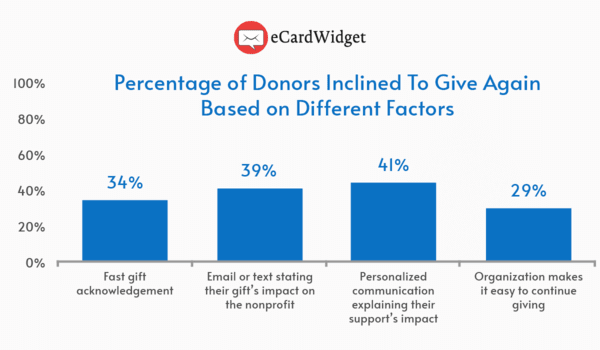
- 34% of donors said they would give again if they received a swift thank you for their contribution.
- 39% said they would give again after receiving an email or text stating their impact.
- 41% of donors would donate again if they received personalized communication on their support’s impact.
- 29% would give again if the organization made it easy to continue donating.
Don’t underestimate the power of effective communication when it comes to retaining donors. Laying out a full donor recognition strategy will help you enhance your communications to form real connections with your donors.

Creating Donor Recognition Tiers
Everyone should feel valued, regardless of how much they give. However, it’s important to choose donor recognition strategies that sufficiently address someone’s level of generosity. To help, you need to define donation amount thresholds and assign specific types of recognition to each.
The parameters you set for tiers will depend on your organization. We’ll explain more about how different organizations’ tiers vary later, but for now, know that each tier should provide levels of acknowledgment that increase in value. For example, someone who gives a $25 donation shouldn’t receive the same level of acknowledgment as someone who donates $2,500.
Choosing Your Tiers
There are a few ways you can break down different donor tiers. You might categorize donation tiers based on one of the following:
- Donation type. Donors typically give via cash, in-kind gifts, or matching gifts. Organize your recognition program to acknowledge their specific type of gift. For example, if someone increases their donation via a corporate matching gift, specifically acknowledge their thoughtfulness in doubling their donation.
- Donation amount. How you determine the amounts for each tier will depend on your nonprofit’s average donation. Smaller nonprofits might see a $200 average donation, while larger nonprofits might see a $1,000 average donation.
- Engagement Level. Consider whether they’re first-time, repeat, major, or legacy donors. Then, tailor your follow-up to match. For example, first-time donors may receive a thoughtful eCard, while repeat donors might receive an exclusive invitation to an annual luncheon.
- Donor type. Individuals, corporations, and foundations should receive different types of recognition. For instance, reserve personalized acknowledgments and donor spotlights for individual donors, large-scale public acknowledgment for corporations, and grant acknowledgments for foundations.
You have several options for separating your donor tiers. Choose the one that best fits your organization, so you can recognize donors meaningfully without going overboard or not doing enough.
Choosing Types of Recognition
Once you’ve defined your tiers, assign relevant types of recognition to each one. There are three main types of recognition you’ll want to consider:
- Personal: This more private form of recognition might include personalized gifts, custom acknowledgment letters, phone calls, personalized emails, or one-on-one meetings with leadership.
- Public: This type of donor recognition includes honor walls, donor walls, major donor clubs, mentions in your annual report, plaques, social media shoutouts, and so on.
- Naming Opportunities: Typically reserved for major donors, this type of donor recognition could include naming a building, rooms, funds, endowments, or campaigns after a specific individual.
This is where knowing your donors comes in handy. Some individuals prefer private, one-on-one outreach, whereas others appreciate public recognition.
Donor Recognition Tiers Example
Let’s take a look at an example of how you might define donation tiers for appropriate follow-up. We’ll use the donation amount approach since that’s one of the most common tactics nonprofits use.
The Sarasota Orchestra provides a great example of effective donor recognition levels:
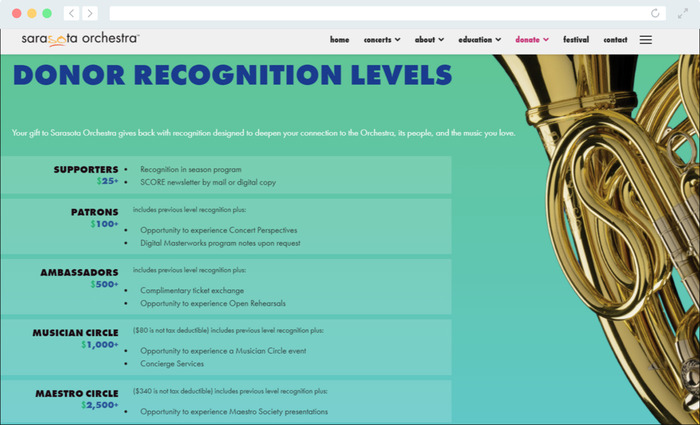
The orchestra’s fundraising team breaks donor recognition levels into several tiers with increasingly better rewards based on how much someone donates:
- Supporters ($25+) – recognition in the season program, newsletter
- Patrons ($100+) – previous level benefits, opportunity to experience Concert Perspectives, Digital Masterworks program notes
- Ambassadors ($500+) – previous level benefits, complimentary ticket exchange, ability to attend open rehearsals
- Musician Circle ($1,000+) – previous level benefits, opportunity to experience a Musician Circle event, concierge services
- Maestro Circle ($2,500+) – previous level benefits, opportunity to experience Maestro Society presentations
- Orchestra Circle ($5,000+) – previous level benefits, opportunity to experience an Orchestra Circle event, photo recognition in Masterworks Program Book
- Impresarios ($10,000+) – previous level benefits, opportunity to experience an Impresarios event
- Virtuosi ($25,000+) – previous level benefits, personalized connections
- Gold Baton ($50,000+) – previous level benefits, opportunity to experience a Gold Baton event
They’re incredibly transparent with how they break down giving levels and the types of donor recognition each level receives. They even share tax deduction details. That way, donors can choose to give amounts that align with their needs and earn the rewards they enjoy most.
Notice how the orchestra also shares a healthy mix of private and public recognition opportunities. Between the newsletter and photo recognition in their program, there’s a reward for everyone!

8 Best Practices for Your Donor Recognition Strategy
While each nonprofit organization finds success in different methods, you can follow industry best practices for your donor recognition strategy. Then, tailor it to match your unique donor base. Here are some best practices to get started.
1. Create a donor recognition plan.
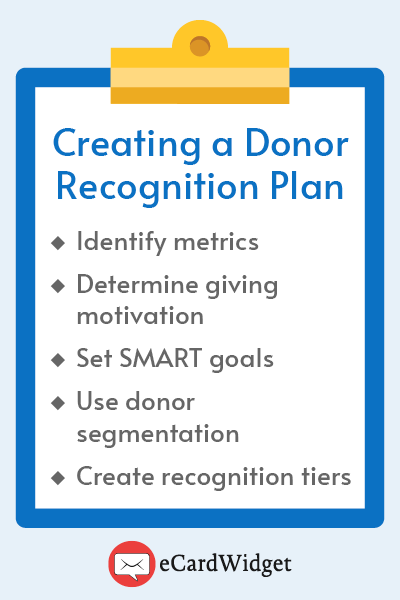
Just like you would create a plan for your fundraising efforts, you should also create a plan for donor recognition. When you are making this plan, you should:
- Identify metrics to track donor engagement. You will use these metrics to evaluate and improve your donor recognition strategies.
- Determine why donors continue to support your nonprofit. After you’ve determined why donors choose to support your nonprofit, you’ll be able to adjust your strategies to maximize donor satisfaction. For example, if certain donors support you because they firmly believe in your cause, be sure to regularly specify how your nonprofit is working towards that cause in your donor communications.
- Set SMART goals. Your goals should be specific, measurable, achievable, relevant, and time-bound. This will give you a good idea of how feasible they are and the work you’ll need to put in to achieve them.
- Use donor segmentation to create personas. By segmenting your existing donors, you’ll be able to create personas of your supporters based on the data you’ve collected. This will allow you to create more targeted messages.
- Create recognition tiers. Although you should show appreciation to all your donors, they will make gifts of varying amounts and therefore require different levels of recognition. For example, a major donor may feel unvalued if you only send them a thank-you email, whereas a smaller one-time donor may feel uncomfortable with a public social media shoutout.
After creating and implementing your plan, review your key metrics to evaluate how well it is performing. Regularly update and make improvements to your donor recognition plan to keep your donors happy.
2. Stay focused on the donor.
To ensure that your donors feel properly appreciated, keep your communications focused on them. Emphasize the role they play in helping your nonprofit make a difference. In your communications, focus on “you” instead of “we” to focus on your donors’ roles. You want to make it clear that they are the driving force behind your nonprofit’s impact.
3. Send prompt thank-you’s.
When you do a favor for someone, you expect that they will show you their gratitude in some way. Donors feel the same way when they make a gift or join your nonprofit’s membership program. Ideally, you’ll want to thank them within 48 hours. Prompt thank-you messages will help your donors feel recognized and appreciated.
Your thank-you communications can take multiple forms, such as a text or an email. Within it, express your genuine gratitude and how important the donor’s contributions are. You should also include the donation tax receipt for their records.
4. Highlight the gift’s tangible impact.
To foster a strong relationship between donors and your nonprofit, be transparent about your operations. You can also leverage this transparency as a way to recognize donors by highlighting the tangible impact of their gifts.
Inform your donors about what you’re putting their gift towards and what goals you’re trying to meet. Specifically address the concrete impact you hope to make with your fundraising campaign. For example, if your nonprofit is an animal shelter that has recently had an influx of puppies, tell your donor that their $50 will feed five puppies for a week. This helps your donor feel appreciated because they’ll be able to clearly understand how they’re helping your beneficiaries.
5. Add personalization.
Part of making your donors feel recognized is letting them know that you’re taking the time to get to know them as individuals. You can achieve this by personalizing your communications. You can do this in a few ways:
- Address donors by their first and last name. This is an easily automated process that makes your donors feel like they really matter as individuals.
- Mention their specific gift amount. You can reference their most recent gift and acknowledge their history of giving if they’re a repeat donor. You might even inform them of the cumulative total of their gifts and the impact you’ve made with all those funds.
- Reference the other ways they’ve been involved. For example, if your donor has not only made a gift but also volunteered, take the opportunity to send a two-in-one thank-you letter for all of the work they’ve done on behalf of your nonprofit. This will make them feel recognized for their efforts.
- Bring up matching gifts. Show donors that you’re making an effort to get to know them by mentioning if their employers have a matching gift program. This will allow them to create an even greater impact without extra cost to them.
By personalizing your messages, you’re reassuring donors that you see them as more than just their gifts. This recognition helps to strengthen your relationships with them, leading to a higher donor retention rate and a more loyal supporter base.
6. Show gratitude year-round.
To reinforce that you see donors as more than the gifts they make, show your appreciation for them year-round. You want your donors to feel that you care about them. Achieve this by sending communications for special occasions such as holidays and birthdays, where you focus on celebrating your donors. Donors will see and appreciate the genuine effort you’re making. You might even inspire them to launch a birthday fundraiser to take their impact even further.
7. Don’t limit yourself to traditional approaches.
Nonprofits everywhere are competing for donors’ attention. Get creative with your donor rewards to stand out from the crowd and inspire donors to stick around.
Especially with technology at your fingertips, you have the power to go above and beyond to show your appreciation. Even doing something as easy as formatting your donor recognition letters as eCards can elicit a positive response. Take the following eCards from Youth For Understanding for example:
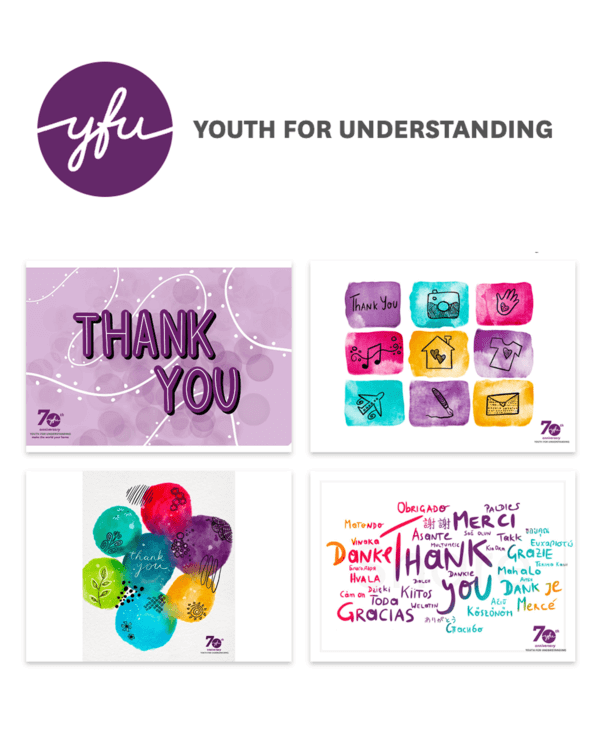
Donors will likely be excited to receive a thoughtful letter paired with an animated, colorful digital greeting card like one of these. Easily design a few thank-you eCards branded to your cause like Youth For Understanding did. When it comes time to recognize donors, choose one of the designs and write a heartfelt note of appreciation.
8. Get permission for public donor recognition.
Not everyone enjoys public recognition. Some prefer private outreach like phone calls or custom greeting cards. You must protect your supporters’ privacy, or your donor recognition strategies will have the opposite effect of what you’re intending. Instead of feeling appreciated, a donor might feel uncomfortable. So, while you want to show off your valued supporters, make sure they’re okay with it first!

23 Donor Recognition Ideas to Improve Retention
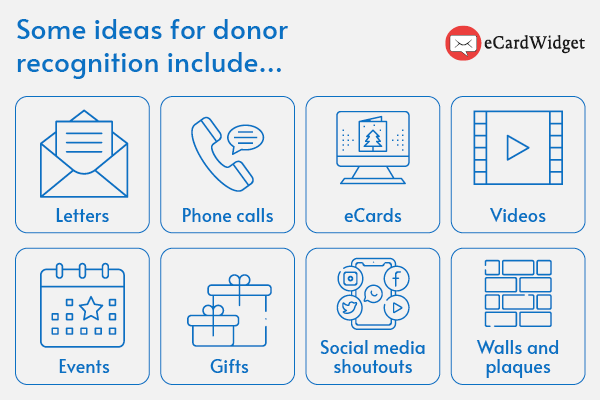
Now that you know the best practices for recognizing your donors, let’s dive into a few donor recognition ideas and the types of donors they would be most suited to.
Custom eCards
Digital greeting cards are a unique and fun way to recognize your nonprofit’s donors. They transform a generic thank-you note into a memorable keepsake. Whether you send them immediately post-donation or for special occasions, donors will love receiving them!
More nonprofits are leveraging this donor recognition idea—and for good reason. Our charity eCards guide explores several benefits, sharing that they are:
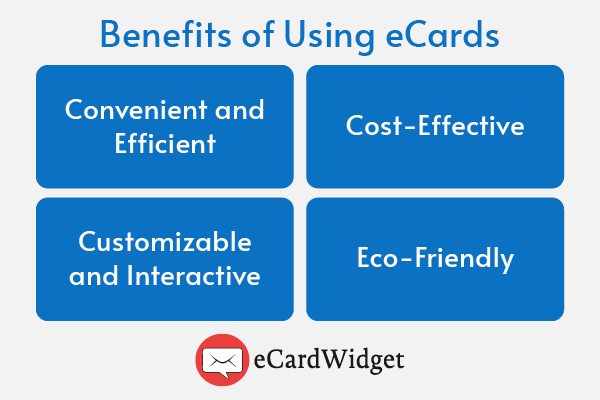
- Convenient and efficient. eCards are extremely easy to send. With the click of a button, you can share custom cards that reach recipients in a matter of minutes, if not seconds.
- Cost-effective. Because of the digital nature of eCards, you won’t have to worry about printing costs or purchasing stamps, making them a very cost-effective way of recognizing donors.
- Customizable and interactive. eCards are incredibly customizable, allowing you to choose the graphics and text on the card. You can even add animated and interactive elements for a more engaging design as seen in Teremana’s animated Valentine’s Day grams.
- Eco-friendly. eCards are usually sent through email, making them eco-friendly and helping your nonprofit reduce its carbon footprint.
When it comes to creating your eCards, work with dedicated eCard software to streamline your process. eCardWidget allows you to design eCards and integrate them into your website easily. This video shows you just how easy it is to create your own custom eCard:
With our eCard software, you’re not limited to just thanking donors. Earlier, we referenced our partnership with Youth For Understanding, which allowed the organization’s beneficiaries to send thank-you eCards to volunteers and teachers who made their experience memorable. The organization found it to be a wonderful way to recognize volunteers and other influential individuals in the program.
You can create greeting cards like these examples, too! Choose from dozens of fonts, select any colors, and even upload your own graphics. No matter who you’re thanking, eCardWidget will equip you with everything you need to create custom eCards that embody your nonprofit’s mission.
Letters and notes
You can send letters and notes to any type of donor. As a classic idea for donor recognition, a handwritten thank-you letter speaks to the effort your nonprofit is making to show your appreciation towards donors. When drafting your thank-you letter, imagine talking to a friend, and adopt that tone in your writing.
In an increasingly technological world, sending thank-you communications through direct mail can help you keep in touch with donors that may be less technologically savvy, such as those belonging to older generations. A physical letter also gives donors a souvenir that they can keep, strengthening their positive experience with your nonprofit.
Phone call
Phone calls are an easy and effective way to recognize your donors. For supporters who value a personal touch, being able to hear a human voice thanking them can be very meaningful. Depending on the size of your nonprofit and the number of donors you have, consider hosting a thank-a-thon, where you have your nonprofit dedicate a day to calling donors and showing your gratitude. Have a script prepared in case your calls go unanswered, so you can leave an appreciative voicemail.
Videos
Videos are another creative way to show your appreciation for your donors. This type of donor recognition is very involved and may require a lot of effort in terms of filming and editing. However, if done correctly, your supporters will appreciate the effort you’ve made.
You can create a general thank-you video for all your donors and post it on your social media, embed it in your email newsletters, or feature it on your website. Another way you can use donor recognition videos is by creating individual, personalized videos for your major donors.
Donor recognition events
Invite your donors to an event specifically celebrating them. These events can be in-person or virtual and range from cocktail happy hours to formal galas. You can use them to recognize all donors or a specific subset, such as major donors or recurring donors. To ensure that attendees have a positive experience, consider what type of event or activities your donors would most enjoy.
Gifts
Send your donors gifts to show your appreciation, such as merchandise branded to your nonprofit, including:
- Hats
- Mugs
- Tote bags
- Water bottles
Aim to relate your gifts back to your nonprofit’s mission—for example, if your nonprofit is dedicated to planting trees and creating a more eco-friendly world, you can send seeds for gardening. This idea is great for recognizing mid-level to major-level donors that you want to show extra gratitude towards.
Giving societies
Giving societies essentially allow your nonprofit to group donors together based on their giving level and reward them for their support by offering special perks and discounts. This idea is best suited to recognizing mid to major donors and recurring donors, who have made a considerable investment in your nonprofit’s success.
Social media shoutout
A social media shoutout allows you to spotlight donors that are significant to your organization and have made large contributions. Ideally, you should recognize major donors in this manner. Make sure that you have their permission before thanking them on social media, as some donors may wish to stay out of the public eye.
Personal meetings
You can have one-on-one meetings with donors to thank them for their support. These meetings are also a great opportunity to ask them why they support your nonprofit and solicit feedback on what you could do better. Because of the involved nature of this form of donor recognition, you’ll want to use it to show major donors that you’re putting effort towards strengthening your relationship with them and that you truly care about what they have to say.
Walls and plaques
When nonprofits put up a donor recognition wall or plaque, they will essentially dedicate a wall to major donors that have made a large contribution to them. You might engrave your donors’ names on the wall or hang plaques instead. You can even create separate sections on the wall to separate your major donors into tiers based on their giving amount. Walls also allow you to recognize other important donors, such as legacy donors.
Thorough receipts
Be sure to issue tax-compliant donation receipts within 48 hours. While it’s not the most exciting donor recognition idea, it’s good practice to send out these acknowledgments! A thorough receipt serves two purposes:
- It acknowledges that your nonprofit received the gift.
- It provides sufficient tax documentation.
If the receipt’s delayed, recognize the gift via postcard, phone call, or email to assure the donor the gift was received and you’ll follow up with appropriate documentation.
Donor-exclusive newsletters
Most donors are invested in your nonprofit’s work and progress, so share regular updates via a donor-exclusive newsletter. You can distribute newsletters either via email or direct mail.
Re:Charity’s donor gifts guide explains that you can “pull your donor into your cause and make them feel like insiders by giving them access to exclusive content.” This type of donor recognition will also incentivize continued giving since they won’t want to lose access to your newsletter!
To simplify the content creation process, you might recycle the same content for all groups and customize only one article for unique audiences.
Outdoor displays
If you have an outdoor space, leverage it to recognize supporters with an outdoor donor recognition statue, monument, or wall. Choose durable materials so that the display can endure weather and sunlight.
Donor luncheon

Invite dedicated donors to a luncheon to say thanks for their generosity. Limit it to a few who have gone above and beyond. Send them a custom invitation, and they’ll be thrilled to join in on conversations with your leadership and other donors.
Host a luncheon either annually or biannually to express gratitude, feature guest speakers, and share success stories in a celebratory atmosphere.
Impact reports
Regularly share impact reports highlighting the tangible outcomes and achievements made possible by your donors’ contributions, demonstrating the real-world change they have helped create.
Include dedicated donor profiles or testimonials in your organization’s annual reports, showcasing the individuals or companies that have made significant contributions. Alternatively, some nonprofits create an annual “gratitude” report.
NXUnite’s guide to donor recognition highlights the Pride Foundation’s Gratitude Report as an excellent example of this donor recognition idea. The guide explains that “In it, you’ll find highlights of the grants and scholarships the foundation was able to award alongside testimonials from those influenced by donations. This approach is a fantastic way to communicate your donors’ impact.”
Named scholarships or programs
Establish named scholarships or programs in honor of significant donors, providing a lasting legacy and recognition of their commitment. You’ll want to reserve this donor recognition idea for major donors.
Donor appreciation days
Dedicate specific days or weeks to honor and recognize your donors. During your dedicated appreciation time, surprise them with special incentives, exclusive content, or gifts to show your appreciation. You can recognize your entire donor base publicly and shine the spotlight on those who have gone above and beyond in their passion for your cause.
VIP experiences
Provide exclusive access to behind-the-scenes tours, priority seating at events, or private meetings with organizational leaders as a way to thank and acknowledge top-tier donors. They’ll appreciate the opportunity to see the inner workings of your organization.
Donor appreciation awards
Establish annual or periodic donor appreciation awards to recognize outstanding contributions, volunteerism, or advocacy efforts. Hand them out at events and other functions as a form of public recognition.
Donor advisory boards
Invite select donors to join a donor advisory board, providing them with a voice and involving them in strategic decisions and initiatives of your organization.
These trusted supporters can provide insights, feedback, and guidance on your organization’s strategies and initiatives.
Holiday or birthday cards
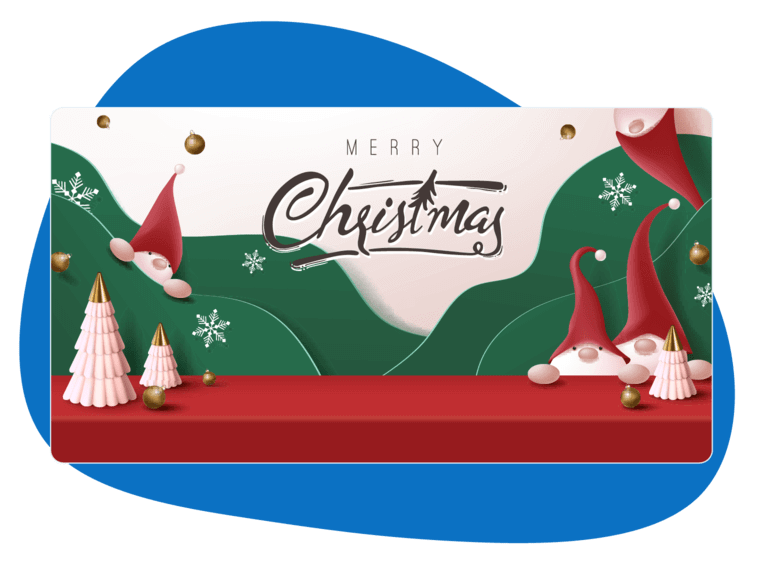
As we mentioned, eCards are incredibly versatile. When you’re backed by the right eCard site, you can create designs for every occasion, from birthdays to holidays. Infuse fun graphics like balloons, cake, confetti, and presents. Be sure to create collections for different occasions, making it easy to select the greeting card you need. Then, choose the design you want, customize the note, and hit send!
Using this donor recognition idea, you can reach out to show them you remembered their special day or are thinking about them during the holiday season. You can even schedule them to send at particular times, so you’ll never forget a donor’s birthday or any other important date!
Testimonials
Any donor invested in your nonprofit’s success will happily share their testimonial. Either record their testimonial, write an article, or pull quotes from the conversation. You can then share their passion for your cause by posting it on your website or official social media pages.
Continuous communication
Sometimes, one of the best ways to show appreciation is by keeping donors in the loop about your organization’s operations. Maintain regular and open communication with donors throughout the year. Update them on your organization’s progress, challenges, and future goals. If they gave to a particular program, be sure to tailor outreach to provide specific updates on it.
Remember, sending nonprofit eCards throughout the year will help strengthen your outreach and make it more consistent.

Resources to Continue Enhancing Donor Recognition
Donor recognition is crucial for nonprofits to retain donors and ensure that they’re happy with their decision to make a gift. Consider similar nonprofits’ donor recognition strategies to give you an idea of what yours should look like, but keep in mind that your nonprofit will have unique needs. Determine what works for your organization and your donors, and implement those strategies.
Keep in mind that eCards are a convenient, meaningful way to thank your donors. This creative form of recognition is much more effective than a generic phone call!
If you’d like to learn more about donor recognition and eCards, here are some additional resources you can explore:
- Charity eCards for Your Nonprofit: A Comprehensive Guide – Curious about how you can leverage eCards for your nonprofit? Check out this guide.
- A Comprehensive Guide to Great Donor Thank-You Letters – Writing the perfect thank-you letter can go a long way toward recognizing your donors. This guide will help you with the basics.
- A Complete Guide to Employee Recognition + Top 10 Ideas – Just like donor recognition, employee recognition is crucial for nonprofit organizations. Learn more here.
